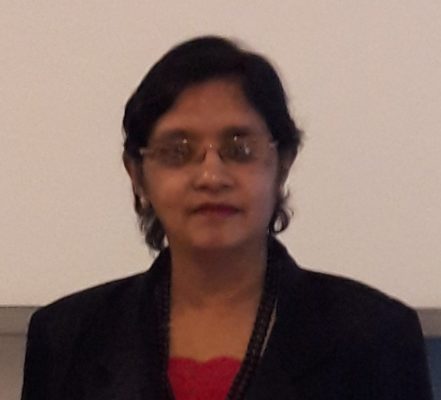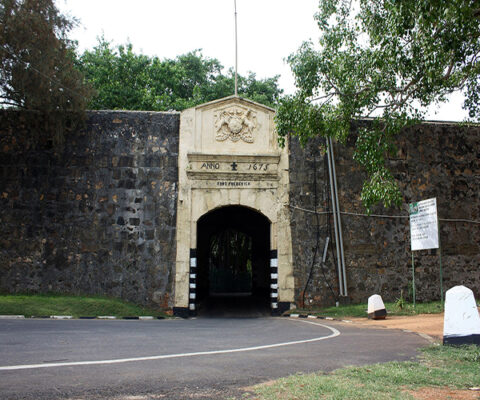Fort Frederick in Trincomalee – emblazoned with colonial insignia
By Arundathie Abeysinghe
 Situated about four kilometers from Trincomalee town center, Fort Frederic also known as Trincomalee Fort or Fort Triquillimale is a fort built by the Portuguese. The Fort was built in 1624 CE on Swami Rock Konamamali from the debris of world renowned ancient Hindu Temple, Koneswaram Temple (Temple of Thousand Pillars). The Temple was destroyed by *Constantino de Sá de Noronha under Phillip II. Fort Triquillimale was dismantled and rebuilt by the Dutch in 1665 and renamed it as Fort Frederick. Later, the Temple was rebuilt.
Situated about four kilometers from Trincomalee town center, Fort Frederic also known as Trincomalee Fort or Fort Triquillimale is a fort built by the Portuguese. The Fort was built in 1624 CE on Swami Rock Konamamali from the debris of world renowned ancient Hindu Temple, Koneswaram Temple (Temple of Thousand Pillars). The Temple was destroyed by *Constantino de Sá de Noronha under Phillip II. Fort Triquillimale was dismantled and rebuilt by the Dutch in 1665 and renamed it as Fort Frederick. Later, the Temple was rebuilt.
Originally, Fort Triquillimale has been a triangular shape. The triangular fort had been outfitted with artillery bastions with the objective defending against British invaders.
In 1795, during the British Colonial Era, the British took over Fort Frederick and added artillery to the Fort. The gateway of the Fort which pierces the sturdy walls is crowned with royal insignias.

According to folklore, the Dutch had enlarged the Fort and British have further expanded it.
Duke of Wellington Arthur Wellesley during his tenure as Colonel in the British East India Company had visited Trincomalee and resided in Wellesley Lodge situated inside the Fort. This lodge is situated within the Fort to date.
According to archaeological excavations conducted within the Fort, there had been Buddhist and Hindu Sculptures of archaeological significance within the Fort. There had also been a Tamil rock inscription belonging to 16 th century AD at the main entrance to the Fort. According to a Sanskrit Rock Inscription dated 1223 AD, there is a description of the arrival of a person known as Godaganga at the Fort premises. Ruins of the ancient Gokanna Monastery which had existed centuries ago had also been found in the premises of the Fort.
Divers who had been diving in the vicinity of the Fort had discovered Buddhist and Hindu Sculptures and brought them ashore.
The Fort is popular among tourists as Koneswaran Temple is situated within the precincts.
There are prominent places in the vicinity of the Fort; Gokanna Rajamaha Viharaya (famous Buddhist Temple), Observation Rawana Abyss (according to legends, *King Rawana had used this place to watch the Indian Ocean) and Lookout Cliff as well as Lover’s Leap.
Located at the end of a narrow peninsula, Fort Frederic has served as a significant defensive site for centuries. Fort Frederick is a legendary monument of Colonial Era *Ceylon. There are herds of spotted deer grazing freely under banyan (Ficus benghalensis) trees in the premises of the Fort. At present, the Fort is used by a detachment of Gajaba Regiment of Sri Lanka Army.
But the Fort can be explored by local as well as foreign tourists.
- Ceylon – Sri Lanka gained Independence from British Colonials in 1948. In 1972, Ceylon became a republic within the Commonwealth and Ceylon was thereafter knownas Sri Lanka.
- Constantino de Sá de Noronha – He was the sixth as well as eighth Governor of *Ceylon during Portuguese rule. He was first appointed under *Philip II of Portugal in 1618 and served as the Governor of Ceylon until 1622 and from 1623 until 1730.
- King Rawana – Mythical Demon King according to Hindu Mythology *Ramayana.
- Mahavamsa– “Great Chronicle” or “Great Dynasty” in Sinhala is the most significant work of Sri Lankan origin written in Pali Language. This Chronicle describes life and times of Sri Lankans from the arrival of Vijaya in 43 BC to the reign of King Mahasena from sixth century BC to fourth century AD. Culavamsa (lesser chronicle) covers the period from fourth century AD to British takeover of Sri Lanka in 1815. Mahavamsa consists of three parts covering a historical record of over two millennia. It is considered as the world’s longest unbroken historical record.
- Philip II – (King Philip II of Spain), He was also known as Philip the prudent. He ruled one of the largest empires; Portugal, Naples, Sicily and also served as the Duke of Milan from 1598-1621.
- Ramayana – This is an ancient Indian epic composed in 500 BCE to 100 BCE by Indian sage Valmiki. This epic composed in Sanskrit describes the conquest of Sri Lanka in 3000 BC by Prince Rama (Prince of Ayodhya, the eldest and favorite son of King Dasaratha, King of Ayodhya. Rama is an incarnation of God Vishnu) who fought with demon King Ravana (legendary emperor of Sri Lanka) to rescue his wife Princess Sita. Prince Rama was exiled with his wife Princess Sita due to a plot by his stepmother Kaikeyi. Princess Sita was abducted by King Ravana when Rama and Sita were in exile.
- Trincomalee – Popular as ‘Trinco’ among locals, Trincomalee is a port city on the northeast coast of Sri Lanka. Trincomalee is situated on one of the world’s natural and beautiful harbors. According to scholars, it may be the site of historic Gokanna asdescribed in *Mahawamsa.







